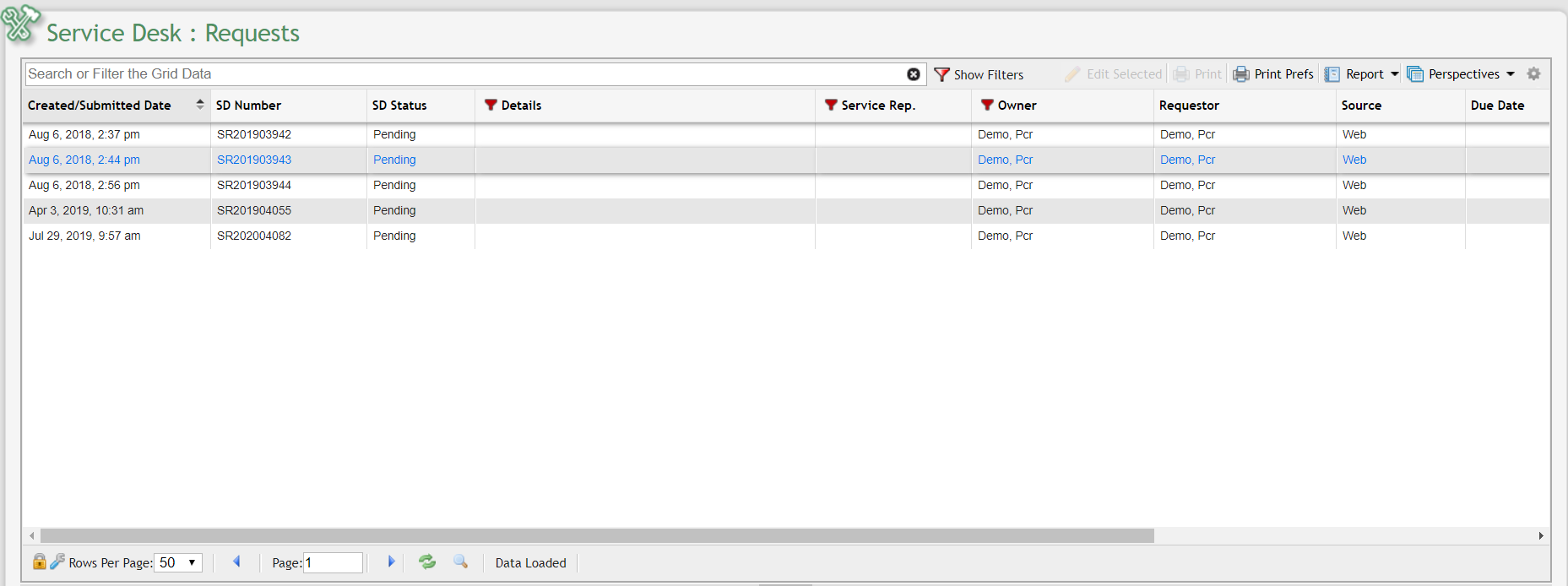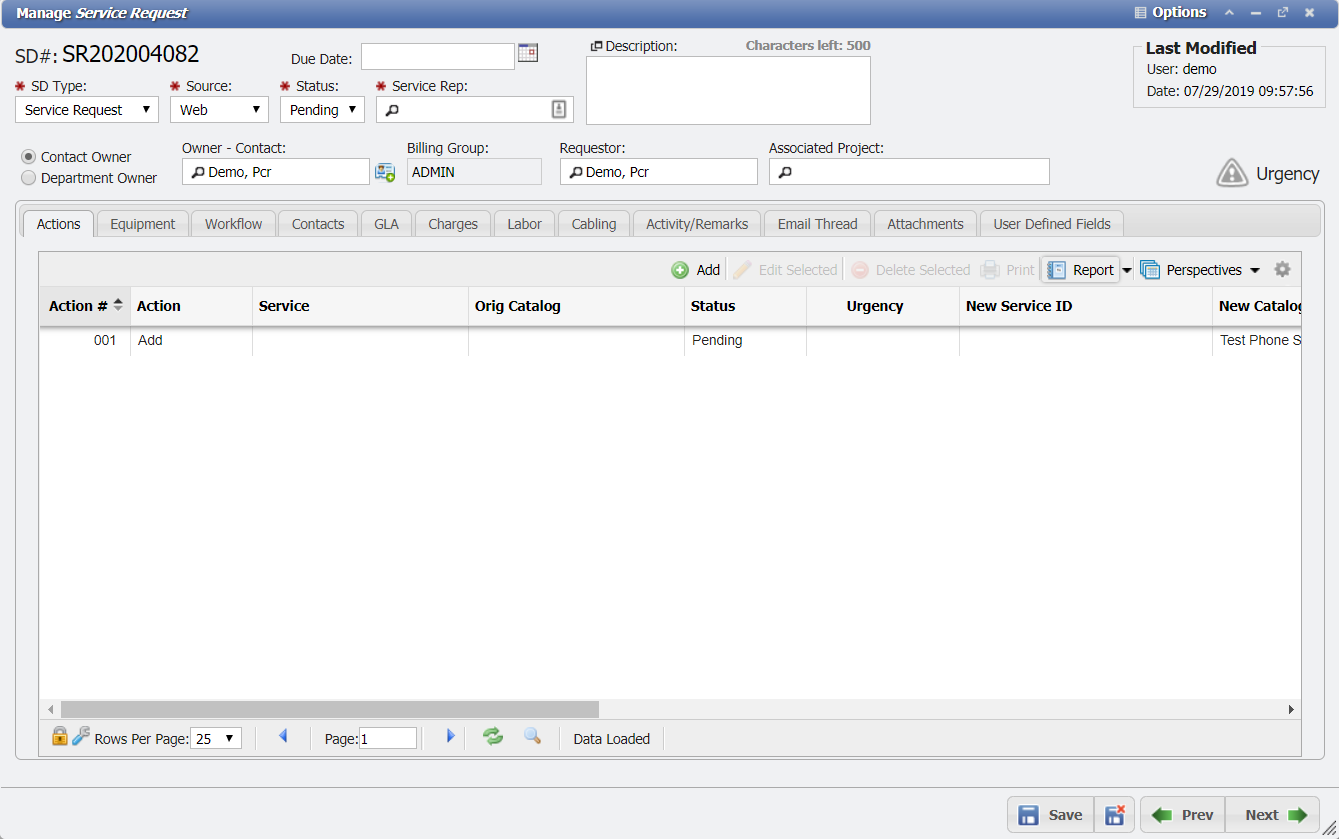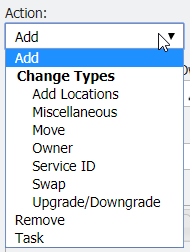Requests
The items that populate the Requests Grid are generated when a User submits a Request to address any number of concerns. The items that appear on the Requests Grid are generated via the CustomerCenter portal, API, or incoming emails. This represents the first stage in the Service Desk process. Whenever a User determines that a new Service is warranted, the User must submit a Service Request in order to initiate the service process.

Service Desk Requests Grid
Since the items on the Requests Grid are populated externally, Users cannot add or delete items to or from the Grid. Instead, Users can double-click an item on the Grid to open its data entry form, at which point the User can choose to advance the Request to the next stage of the service process.
From the Main > Service Desk > Requests grid, a User is able to view the Assigned Workers, Completed Workers, Assigned Workgroups, and Completed Workgroups related to each item.
Types of Requests
The Requests Grid contains three distinct types of Requests for Service.
A Service Request is the standard method by which Users request a Service. Users can identify a Service Request by the initials SR in the column labeled SD Number.
An Incident Request is typically generated by a customer that has reported a specific problem with a piece of Equipment or Service. Users can identify an Incident Request by the initials 'IR' in the column labeled SD Number.
An Inquiry is generated when the User organization's Service Desk email account receives an email from a Customer seeking clarification or consideration for a concern. New incoming emails are processed and designated as new Inquiries or added as threaded messages to existing Service Desk items. Inquiries can also be generated by the CustomerCenter General Request link. Users can identify an Inquiry by the initials 'IQ' in the column labeled 'Number'. For more information on Inquiries, see the Original Inquiry tab page.
Each type of Request can ultimately progress to the next stage of the Service process.
Data Entry Form
Input Fields
The input fields at the top of the Service Request data entry form allow Users to define the Request in terms of its 'Source', 'Status', 'Service Rep', 'Due Date', and more.
Users can easily define 'Source' and 'Status' by selecting the appropriate option via the input field's drop-down menu. Source refers to the source of the request: Phone, Fax, Email, Tech, or Web. Status is used to identify the current state of the Request: ‘Pending’ on ‘Hold’, ‘Void’, or ‘Denied’.
When editing a Service Request, Users may also change the Service Rep – the employee who is responsible for the Service Request's ultimate execution. Clicking on the Search Icon in the 'Service Rep' field brings up a list of Service Reps from the company’s employee catalog. Selecting the appropriate person from this list populates the Service Rep field on the Service Request with the selected name.
Several input fields carry over information from the Requestor in order to simplify the process for the User. Typically, the Requestor's contact information is displayed in the Requestor field.
Note: The Requestor can request a Service on behalf of a different Owner.
Tabs
The Tabs associated with Service Requests are Reported Problem, Equipment, Workflow, Contacts, GLA, Charges, Labor, Cabling, Activity/Remarks, Email Thread, Attachments, Original Inquiry, and User Defined Fields.
Editing a Service Request

Manage Service Request Form
On the Requests Grid, double-click or highlight any existing item and click the ![]() button above the Grid to edit.
button above the Grid to edit.
After opening an item on the Requests Grid, the User is presented with the item's data entry form where the User can begin to address the Request by adding critical information and building Workflows.
Adding a Service Action
From the Actions tab click the
 button.
button. The Add New Service Desk Action dialog opens.
Select the Action you need from the dropdown.

Service Desk Action field Dropdown example
Select the Service Catalog picker.

Service Catalog Picker example
Add any other relevant overrides.
Click the
button.
Advancing a Service Request
The Service Request is exactly that, a Request for Service. Once you have determined that the Request is valid, enter the GLAs and other pertinent information. You may then convert the Service Request to a Service Order. Converting a Request is necessary when it is determined that the Request is valid and requires the installation, removal, or changing of the Requestors Service(s). A User may convert the Service Request to a Service Order at any point in the process as long as all required data fields have been satisfied.
To convert the Request to a Service Order, open the Service Request's data entry form and change the SD Type from Service Request to Service Order. The User is prompted to confirm this change. If accepted, the Service Desk item disappears from the Service Request Grid and appear on the Service Order Grid.
Advancing an Incident Request
The Incident Request is exactly that, a request to create an Incident. Once you have determined that the Request is valid, enter the GLAs and any other pertinent information. You may then advance the Incident Request to an Incident. Advancing a Request is necessary when it is determined that the Request is valid and requires the installation, removal, repair, or changing of the Requestor's Service(s) or Equipment. A User can advance the Incident Request to an Incident at any point in the process as long as all required data fields have been satisfied.
To advance the Request to an Incident, open the Incident Request's data entry form and change the SD Type from 'Incident Request' to 'Incident'. The User is prompted to confirm this change. If accepted, the Service Desk item disappears from the Incident Request Grid and appears on the Incident Grid.
Advancing an Inquiry
An Inquiry is generated when a User emails the designated Service Desk email account with a question. Based on the contents of the email you may then determine if the Inquiry should be Voided or converted into an Incident, Service Order, Estimate, Project, or Problem. An Inquiry is typically Voided if it is an invalid email, spam, or duplicate email.
To convert the Inquiry to another Service Desk type (Incident, Service Order, Estimate, Project, or Problem), open the Inquiry's data entry form and change the SD Type from Inquiry to Incident, Service Order, Estimate, Project, or Problem. The User is prompted to confirm this change. If accepted, the Service Desk item disappears from the Service Request Grid and appears on the Grid for the updated Service Desk type.
For information on recommended practices for Emails, please see: Best Practices for Emails and Inquiries.
